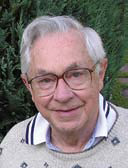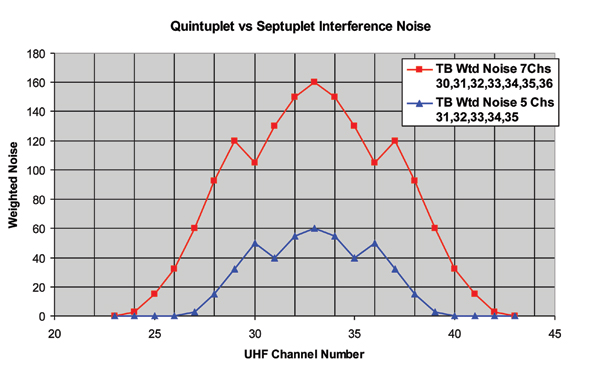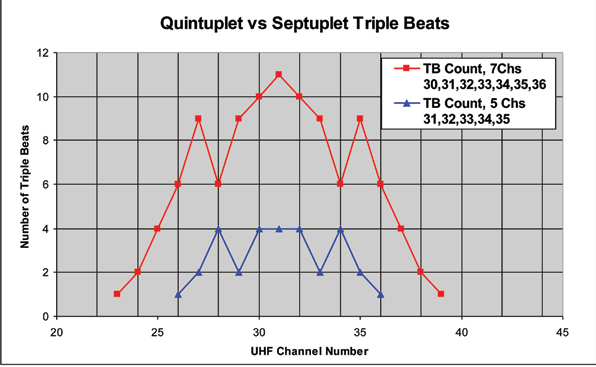The Effects of ACI on UHF Channel Allotments

Charles W. Rhodes
Last month, this column introduced a scheme for allocating UHF band channels by analyzing a set of contiguous channels for a given community. For example Channels 30, 31, 32, 33, 34, and 35 might be allocated to a given community (see Fig. 1).
However, each of these is subject to adjacent channel interference (ACI). Channels 30 and 35 would be exposed to one undesired (U) signal, all others would be subject to ACI from two adjacent channels. ACI is limited by the Desired (D)-to-Undesired power ratios given in Table 5A and FCC/OET Bulletin 69 (D/U = –26 dB).
If all seven transmitters on these contiguous channels were co-sited, ACI would not occur because the power received throughout the service area of these stations should not vary by more than is allowed in Table 5A. But what about communities where there are multiple transmitter sites? Allotments of contiguous channels would probably require co-siting.
Our laboratory testing of both NTIA-approved converter boxes and modern DTV receivers shows that ACI is due to the sideband splatter radiated in the D channel by a DTV transmitter operating on either channel adjacent to the D channel. It is not due to third-order distortion products generated in receivers.
REDUCING ACI THROUGH RE-ALLOCATION
Ideally adjacent channels should not be allocated to the same community. In many cases there are three communities far enough apart that adjacent channels can be allocated to these communities without causing ACI. Consider three such communities, A, B and C. Each community has different channels allocated to it to avoid co-channel interference (CCI). This may allow shorter spacing between A, B and C.

Fig. 1: Spectrum plot of 7 ATSC signals on contiguous channels. This would require co-siting. ACI should not occur because of the distances between these communities. Such a set of allotments is shown below.
A Channels:
14, 17, 20, 23, 26, 29
B Channels:
15, 18, 21, 24, 27, 30
C Channels:
16, 19, 22, 25, 28, 31
This scheme eliminates CCI and ACI and thus would meet the requirements set forth in the 2012 legislation authorizing the FCC to auction UHF TV channels. However many of the channels within each block may be what were called taboo channels in the days of analog TV. These would be subject to taboo channel interference (TCI).
According to the FCC’s Sixth Report and Order, there would be no interference between DTV signals on taboo channels because it was then believed that DTV receivers could reject interference 60 dB greater than the D signal’s received power. That is a D/U ratio of –60 dB, which was highly improbable. The commission discovered that particular error when testing set-top converter boxes for the NTIA in 2008 and published in the December 2010 issue of “IEEE Transactions on Broadcasting.” We found that modern (2013) DTV receivers can reject taboo signals as shown in Table 1.

Table 1: Threshold D/U ratios of modern (2013) DTV receivers
The limit D/U numbers for both ACI (one U on channel N+1 only), and for taboo interference— N+2 to N+6 inclusive—are given for one U signal and for the worst case combination of U signals on Channels N+K and N+2K. Where the predicted D/U is more negative than that shown in Fig. 1, reception may fail. In fact, at these D/U numbers, 10 percent of our receivers failed.
Remember that the FCC D/U limit for ACI is –26 dB. This is why we should minimize adjacent channel allotments. In the FCC’s lab tests of ATSC converter boxes for the NTIA, two U ATSC signals on certain pairs of channels of the form N+K and N+2K (K in an integer), were tested. Interference was found and reported in the above in the previously mentioned issue of “IEEE Transactions on Broadcasting,” (pp. 441–451).
Later my colleagues and I repeated these tests on NTIA-approved converter boxes and obtained similar results. In subsequent papers published by the IEEE Consumer Electronics Society, we reported that such interference affects not only Channel N, but also a second Channel N+3K. This doubles the threat of the heretofore unknown interference mechanism.
My colleague, Linley Gumm and I recently tested 24 DTV receivers built in 2013. Modern ATSC receivers have tuners that are implemented as an integrated circuit. These tuners have quite different performance characteristics concerning interference with respect to the tuners in NTIA-approved converter boxes.
Those tuners were mostly single-conversion tuners with the usual 44 MHz IF and were built with discrete components. IC tuners are much smaller, consume less power and cost less than tuners used before 2013 in ATSC receivers. They are here to stay.
The 2013 vintage receivers that we tested are less robust against interference from two or more U ATSC signals than were the vintage 2008 NTIA-approved converter boxes. This is unfortunate because we anticipate greater density of DTV stations after the repacking than we now have. That suggests more interference after repacking.
AVOID CONTIGUOUS CHANNELS WITHIN A BLOCK
Fig. 2 shows the weighted third-order noise power for both a five channel block (blue trace) and a seven channel block (red trace). Note that there is much more noise power per channel in the seven channel block than in the five channel block. However there are more channels for a given community with seven channels per block than five.

Fig. 2: Third-order distortion products (noise) in each channel for a block of 5 or 7 Channels.
My colleague Stan Knight has analyzed the build-up of third-order distortion products (noise) in the receiver’s mixer in each channel of a block of six channels. Six channels per block is a compromise between five and seven channel blocks.
Channels 23, 24, 25, 26, 27, 28
Noise 83, 100, 115, 115, 100, 83 units
A much quieter set of channels consists of:
Community A Channels
14, 16, 20, 23, 28, 30
Noise 13, 20, 15, 24, 18, 19 units
Community B Channels
15, 17, 21, 24, 29, 31
Noise 18, 20, 15, 24, 18, 19 units
Community C Channels
18, 22, 25, 27, 32, 35
Noise 15, 25, 29, 22, 26, 19 units
There is a difference of up to 7 dB in noise levels between contiguous channels and non-contiguous channels.
What these calculations show is that contiguous channels within a block should be avoided and that there is a significant difference in noise in these channels depending on the mix of channels in a given block.
The above data set we now know is not the best possible, but that was not the objective of these calculations. Knight found that the noise levels differ substantially so it would be necessary to find the optimum set of channel numbers. This noise adds to the receiver-generated noise to create the noise floor under a given channel. This in turn may determine the minimum usable received signal power, hence the coverage of a station where interference, not receiver noise, is the limiting factor after repacking unless great care is taken in the repacking algorithm.
As this noise (due to interference) is generated in the receiver, the only way to reduce it is to improve the linearity of future tuners. With tuners-on-a-chip this may be impossible because it would probably require running more power in the tuner circuitry which may cause the junction temperature to exceed safe limits. Moreover, improving linearity would only benefit a small percentage of consumers while any cost increases would be passed along to all consumers. While future receivers may manage this, what about the millions of ATSC receivers now deployed?
After repacking, we will move from a noise-limited coverage world to an interference- limited world, but this situation is not all bad. Remember that we have eliminated ACI. But removing ACI and replacing it with TCI is not progress. I suggest that we can eliminate ACI as shown above and control TCI by taking great care in the allotment process. I suggest that we can do this under the constraints imposed by the legislation referred to above.
As the need for better spectrum efficiency increases, some vast nationwide scheme such as we have used in the past, may have to be modified for the different regions of the country. For example, the trios described above are well-suited to the midwest, while along both coasts there are long, high-population density regions where two communities need protection rather than three and they could have more channels.
In summary, CCI can only be avoided by the spacing between the transmitters and directional (roof-mounted) receiving antennas. ACI is completely avoided by not allocating adjacent channels in the same community, and TCI can be minimized by the choice of channels allocated to a given community.
Happy Holidays to all my readers.
Charles Rhodes is a consultant in the field of television broadcast technologies and planning. He can be reached via email atcwr@bootit.com.
Get the TV Tech Newsletter
The professional video industry's #1 source for news, trends and product and tech information. Sign up below.
